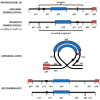A Peruvian Child with 18p-/18q+ Syndrome and Persistent Microscopic Hematuria
- PMID: 29142771
- PMCID: PMC5683951
- DOI: 10.1055/s-0037-1604099
A Peruvian Child with 18p-/18q+ Syndrome and Persistent Microscopic Hematuria
Abstract
Chromosome 18 pericentric inversion carriers could have offspring with recombinant chromosomes, leading to patients with clinical variable manifestations. Patients with 18p-/18q+ rearrangements share some clinical characteristics, while other characteristics differ. Factors for such divergence include the length of the inverted segment, among others. Here, we describe a Peruvian child with dysmorphic features, intellectual disability persistent microscopic hematuria, aortic pseudocoarctation, and descending aorta arteritis, among others. Karyotype analysis of family members determined the mother as the carrier of a pericentric inversion: 18[inv(18)(p11.2q21.3)]. This child carries a recombinant chromosome 18, with chromosomal microarray analysis detecting two genomic imbalances in patient's chromosome 18: one duplicated region and one deleted segment in the large and the short arms, respectively. Persistent microscopic hematuria has not been reported among 18p-/18q+ phenotypes. Our patient elucidates that other factors play significant and yet unknown roles for not fulfilling the proposed genotype-phenotype correlation associated with hemizygosity in this type of recombinant chromosome 18 or presenting these features as the patient ages.
Keywords: chromosome 18 pericentric inversion; genotype–phenotype correlation; hematuria; microarray analysis; recombinant chromosome 18.
Conflict of interest statement
Figures







Similar articles
-
Partial 18q trisomy and 18p monosomy resulting from a maternal pericentric inversion, inv(18)(p11.2q21.3).Jinrui Idengaku Zasshi. 1991 Sep;36(3):257-65. doi: 10.1007/BF01910544. Jinrui Idengaku Zasshi. 1991. PMID: 1753439 Review.
-
Familial pericentric inversion of chromosome 18: behavioral abnormalities in patients heterozygous for either the dup(18p)/del(18q) or dup(18q)/del(18p) recombinant chromosome.Eur J Hum Genet. 2005 Jan;13(1):52-8. doi: 10.1038/sj.ejhg.5201281. Eur J Hum Genet. 2005. PMID: 15470365
-
Partial deletion of 18p and partial duplication of 18q caused by a paternal pericentric inversion.Clin Genet. 1996 Dec;50(6):520-4. doi: 10.1111/j.1399-0004.1996.tb02726.x. Clin Genet. 1996. PMID: 9147887 Review.
-
Recurrent proximal 18p monosomy and 18q trisomy in a family due to a pericentric inversion.Am J Med Genet A. 2014 May;164A(5):1239-44. doi: 10.1002/ajmg.a.36410. Epub 2014 Jan 29. Am J Med Genet A. 2014. PMID: 24478222
-
Prenatal diagnosis and molecular cytogenetic characterization of partial dup(18q)/del(18p) due to a paternal pericentric inversion 18 in a fetus with multiple anomalies.Taiwan J Obstet Gynecol. 2019 May;58(3):318-323. doi: 10.1016/j.tjog.2019.03.005. Taiwan J Obstet Gynecol. 2019. PMID: 31122516
Cited by
-
Pseudocoarctation of aorta: a very rare anatomic anomaly.Indian J Thorac Cardiovasc Surg. 2020 Sep;36(5):530-532. doi: 10.1007/s12055-020-00976-3. Epub 2020 Jun 22. Indian J Thorac Cardiovasc Surg. 2020. PMID: 33061169 Free PMC article.
-
Vertical inheritance and unique differential phenotypes of reciprocal recombinant chromosome 18 within a multi-generation family.Eur J Hum Genet. 2025 Jul 8. doi: 10.1038/s41431-025-01878-x. Online ahead of print. Eur J Hum Genet. 2025. PMID: 40628998
-
Molecular cytogenetic identification of small supernumerary marker chromosomes using chromosome microarray analysis.Mol Cytogenet. 2019 Mar 11;12:13. doi: 10.1186/s13039-019-0425-5. eCollection 2019. Mol Cytogenet. 2019. PMID: 30911334 Free PMC article.
-
Genetics and genomics in Peru: Clinical and research perspective.Mol Genet Genomic Med. 2018 Nov;6(6):873-886. doi: 10.1002/mgg3.533. Mol Genet Genomic Med. 2018. PMID: 30584990 Free PMC article. Review.
-
The molecular mechanisms of recombinant chromosome 18 with parental pericentric inversions and a review of the literature.J Hum Genet. 2023 Sep;68(9):625-634. doi: 10.1038/s10038-023-01157-x. Epub 2023 May 10. J Hum Genet. 2023. PMID: 37161033 Review.
References
-
- Muss B, Schwanitz G. Characterization of Inversions as a Type of Structural Chromosome Aberration. Int J Hum Genet. 2007;7(02):141–161.
-
- Hasi-Zogaj M, Sebold C, Heard P et al.A review of 18p deletions. Am J Med Genet C Semin Med Genet. 2015;169(03):251–264. - PubMed
-
- Lustosa-Mendes E, Dos Santos A P, Viguetti-Campos N L, Vieira T P, Gil-da-Silva-Lopes V L. A boy with partial dup(18q)/del(18p) due to a maternal pericentric inversion: genotype-phenotype correlation and risk of recombinant chromosomes based on systematic review of the literature. Am J Med Genet A. 2017;173(01):143–150. - PubMed
-
- Hall J G, Allanson J E, Gripp K W, Slavotinek A M. New York, NY: Oxford University Press; 2007. Handbook of Physical Measurements. 2nd ed.
Publication types
LinkOut - more resources
Full Text Sources
Other Literature Sources

